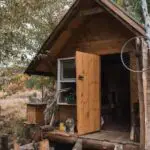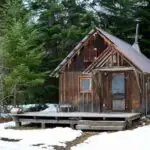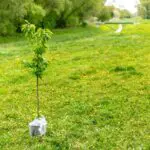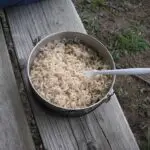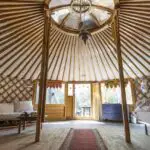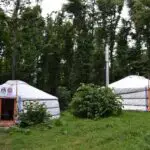Have you been dreaming about building a cabin in the mountains? Perhaps you have, but you’re worried about costs, so you’re considering using green logs.
Is it possible? How do you begin building a log cabin with green logs? What other concerns are there?
This article has you covered, so relax and keep dreaming.
Going Green Is Possible
The first thing to know about building a cabin with green logs is that it’s possible. In fact, it’s only been fairly recently that the switch has been made from green logs to seasoned wood.
The next time you set foot inside a 200-year-old historical cabin, rest assured that green logs were likely used and they can stand the test of time.
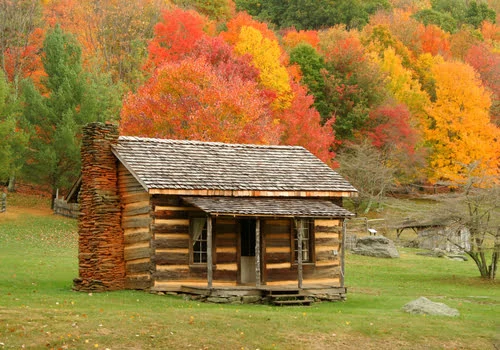
Difference Between Green Logs And Seasoned Logs
Green logs or wood refers to trees that are freshly cut and have not yet dried. Seasoned logs are made from wood that has been cut and dried. Air drying occurs naturally and takes 2-3 years for most wood.
Logs can also be kiln dried using air currents that circulate around the logs to expedite the drying process.
Kiln-dried wood is favored over green wood for building structures as it doesn’t shrink and is less prone to cracking and warping, but green logs are still a good alternative.
Pros And Cons Of Using Green Logs
The two biggest advantages of using green logs are cost and speed.
Kiln-dried wood is expensive due to the costs associated with the drying process.
Air-dried wood is a little cheaper, but you will have to wait years if you want to dry your own logs.
There are no treatment costs associated with green logs and you can use them immediately if you fell them yourself.
Green logs are also easier to work with as they are softer and more flexible due to the retention of moisture, and they are easier on tools.
Unfortunately, due to the softness and moisture, green logs can warp and crack as they dry over time. Additionally, green wood will shrink substantially more than seasoned wood as the moisture slowly evaporates.
Lastly, green logs will weigh substantially more than seasoned logs due to all the excess moisture which can be an added burden during construction.
Connecting The Logs
Now that you have the logs, you need to know how to build a cabin.
Below are the basic steps needed to turn your felled trees into your mountain retreat.
- Cut, transport, and debark trunks
- Cut boards for a door
- Lay the foundation of the cabin
- Stack logs to build walls, framing windows and doors as you go
- Finish flooring
- Cut gables and place beams for the roof
- Add roof and any necessary insulation for it
- Chink gaps and caulk small checks in logs
- Install doors and windows
- Treat wood if necessary
It is important to note that all cabins need to have a proper foundation to keep the logs off the ground.
Concrete slabs are a very popular option, but there are others to choose from as well.
Ensure that the logs are not in contact with the ground to prevent issues with moisture, insulation, termites, etc.
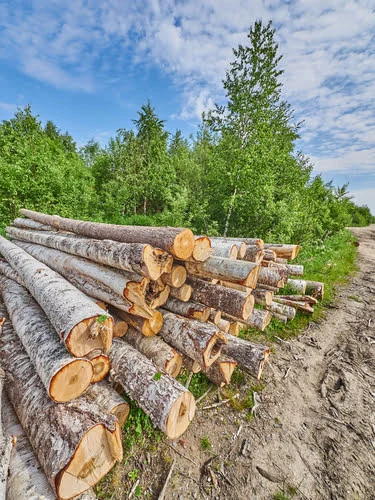
Chinking Basics
Chinking is the material that fills in the gaps between the logs. It can be made of either rough mortar or synthetic materials like acrylic or petrochemical elastic compounds.
While you can use either type of chinking, it is suggested that synthetic chinking be used with green logs as it is more flexible and allows the logs to breathe.
This is important given that green logs can take up to 5 years to fully dry.
Mortar chinking is an attractive option because it is 10% the cost of synthetic, but it only lasts 20-30 years.
Synthetic chinking is expected to last longer, but given that it’s a recent innovation, there is not a lot of information available about its longevity.
It should also be mentioned that all types of notched cabins require chinking except for cabins built using the Scandinavian Chinkless method in which the entire log is notched and not just the corners.
Chinking vs Caulking
You will frequently hear “chinking” and “caulking” used interchangeably in the cabin building world, but make no mistake they are not the same thing.
Caulking is only used for narrow cracks and smaller logs, while chinking is used for larger gaps and bigger logs.
A general rule of thumb to follow is to use caulk for logs 6 inches or less in diameter and for cracks less than 1 inch wide. Chinking should be used on logs larger than 6 inches in diameter and for any gap wider than an inch.
Chinking can fill a gap of 1-5 inches, while caulking is ideal for filling smaller checks (cracks in logs).
While the two compounds might be made of similar substances, their uses are quite different.
A Concern For Builders Using Green Logs
The biggest concern that a log cabin builder will probably have with using green logs is that green lumber is ungraded.
Lumber grades are used to judge the quality of a piece of lumber. It helps a builder know whether to use a piece of lumber for subflooring or paneling.
While your builder might not mind using ungraded lumber, the building codes for your area might prohibit or limit its use.
NOTE: If you are planning on building a cabin on public land, read this first.
But always be sure to check with your local code enforcement office before starting your project to prevent any unwanted surprises down the road.
Tips And Tricks
While you might be building your first cabin, plenty of others have gone before you. Here are a few golden nuggets of advice from those who already blazed this trail.
Begin At The Ends
Moisture evaporates 10-12 times faster from the ends of green logs than it does from any other part of the trunk.
In order to slow the drying process to ensure that ring separation and cracks don’t form, seal the ends of the logs when they are cut. Almost anything can be used as a sealant, but some common options include paraffin wax, polyurethane, shellac, and latex paint.
Sealing is a simple step that helps to control the drying process and protects the integrity of the wood.
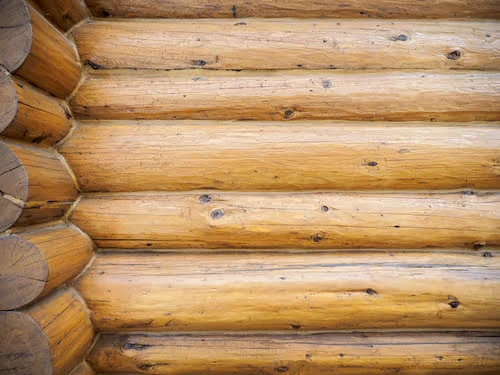
There Will Be Shrinkage
If you build with green logs expect a lot of shrinkages, especially in the first few months.
In a warm and dry climate, 70-80 percent of the total shrinkage of green logs will happen in the first 3-4 months after the logs leave the sawmill. The logs will continue to dry over the next 1-2 years, but the contraction from that drying will be minimal.
The best way to deal with shrinkage is to plan for it, and this is especially important if you plan on building a cabin with a loft because the additional weight of a second story will put pressure on green logs.
Avoid using logs over 6 inches in diameter if possible as narrow logs shrink less than large logs.
Also, draw plans for your cabin with overlapping details so the gaps will be more minimal once all the logs have shrunk.
Lastly, cut unseasoned lumber in the fall when the weather is cool and sap is low, to slow the drying process and reduce the amount of stress caused by fast drying.
Chinking And Stains
If you decide to use synthetic chinking and opt to stain your cabin, be sure to choose your stain and chinking carefully.
Ensure that both products are made by the same manufacturer and are part of a system that is meant to be used together to avoid any damaging interactions between the two.
Also, if using an oil-based stain, it is important to apply the stain first and then chink the cabin afterward. If staining with a water-based product, stain first and then chink second.
Finishing Touches
Once your cabin is built, go over all the logs and fill any checks that are larger than 2 inches. Don’t just look for horizontal cracks, but vertical checks as well.
Also, it is not necessarily required that you seal the outside of your cabin upon completion. There are mixed opinions about sealing green logs.
It is recommended that you wait a few months for the logs to dry before applying a sealant to the exterior, but the overall decision of whether or not to seal comes down to the type of wood used. It is essential that some woods be sealed while it’s optional for others.
The type of wood you used will determine if your cabin needs to be sealed and what type of sealant to use.
Conclusion
While it’s ideal to build a cabin with seasoned lumber, don’t be deterred from building yours with green logs.
Just remember to seal the ends of the logs immediately, be prepared for shrinkage, and use a chink that lets your lumber breathe enough to dry properly.
Now, stop dreaming about that cabin in the mountains and start building.
You May Also Like: Yurt vs A Frame Cabin: Best Choice For Minimalist Living?
Related Posts
- Can You Build a Cabin on Public Land? Tips You Should Know!
- What to Pack For A Winter Cabin Trip (With List & Tips!)
- Can You Plant Trees On Public Land? Allow Me To Explain!
- Why Does Pasta Take Longer to Cook in the Mountains?
- Yurt vs A Frame Cabin: Best Choice For Minimalist Living?
- Do Yurts Have Bathrooms?
